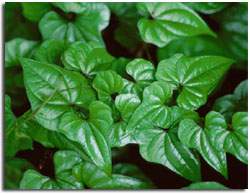
Wild Yam – Standardized Extract (6% Diosgenine)
Botanical:
Dioscorea villosa; Dioscorea batata
Family: Dioscoreaceae (yam)
Other common names:
Colic Root, Devil’s Bones, Bitter Yam, Barbasco, Yuma, Liver Root, Rheumatism Root, Wilde Yamwurzel, China Root
The many varieties of Wild Yams have been used worldwide for so many medical applications that it is difficult to enumerate all of them. The Wild Yam is high in plant hormones, which may be synthesized by the body to support its own hormone health (Wild Yams have provided the source material from which birth control pills are derived). The Wild Yam also includes steroidal saponins, which are used in the preparation of steroids (cortisones) by the pharmaceutical industry. For women who want to continue the normal balance of hormones, benefit from relief of pains and aches or simply enjoy overall good health, why not try an old and natural way with Wild Yam.
Disclaimer:
The information presented herein by Herbal Palace is intended for educational purposes only. These statements have not been evaluated by the FDA and are not intended to diagnose, cure, treat or prevent disease. Individual results may vary, and before using any supplements, it is always advisable to consult with your own health care provider.
History:
Wild Yam (not to be mistaken for our Thanksgiving sweet yam) is a hardy, twining plant with long, knotty, matted, contorted, ligneous rootstocks. This climbing perennial may grow to a height of twenty feet and bears pointed, heart-shaped, ovate, hairy leaves and drooping green-yellow flowers that appear in summer. The plant thrives in rich, well-drained soil in sun or partial shade and may be found mostly in moist woods and along roads in North America, with many other varieties distributed throughout Central and South America, Africa, and many parts of Asia; and the long, branched, crooked woody roots are used for numerous medicinal applications. Yams provide the source material from which birth control pills, cortisones, and sex hormones are derived, and until the hormone was synthesized in 1970, Wild Yam was the sole source of diosgenin for contraceptive pills. In Mexico, Indian women utilized the Wild Yam for birth control and to prevent miscarriage; and in the United States, it also played an important part in herbal medicine, where it was employed as a contraceptive, diuretic, emetic, expectorant, and remedy for colic and muscle spasms. Yams are high in plant hormones, which may be synthesized by the body to support its own hormone health (and is, thus, an important constituent in hormone regulating herbal formulas). Moreover, many species contain steroidal saponins, which are used in the preparation of steroids by the pharmaceutical industry. Some of the constituents in Wild Yam include a high saponin content, beta-carotene, diosgenin, starch, tannin, calcium, chromium, iron, magnesium, manganese, phosphorus, potassium, selenium, zinc, B-vitamins and vitamin C.
Beneficial Uses
Wild Yam is believed to be a wonderful, natural hormone regulator. The herb contains compounds that are similar to female hormones (progesterone and estrogen), which have been helpful for female disorders, including premenstrual syndrome (PMS), menopausal-related symptoms and dysmenorrhea (painful menstruation). Moreover, Wild Yam contains a natural steroid called dehydro-epiandrosterone (DHEA) that is said to rejuvenate and give vigor to lovemaking.
With further regard to hormonal support, Wild Yams once provided the sole source material (diosgenin) from which birth control pills and sex hormones are derived. This supports the herb’s historical use in folk applications when used for contraception, easing the pains of childbirth, restoring hormonal balance after birth and alleviating nausea during pregnancy (no longer recommended).
Wild Yam is thought to be an antispasmodic that relieves muscular cramps, abdominal cramps, ovarian and uterine pain, irritable bowel syndrome, spasmodic hiccoughs, spasmodic asthma and menstrual cramps (a further support for women’s complaints).
The steroidal saponins in Wild Yams have provided the source material from which cortisones are derived and are used in the preparation of steroids by the pharmaceutical industry. This has been beneficial in cases of inflammation and easing painful arthritis and rheumatism.
Wild Yam is said to be soothing on the nerves (and body) and beneficial for neuralgia anywhere in the body, pains in the urinary tract and digestive problems. The herb has been used to expel gas from the stomach and bowels, and not only relieve wind, but also colic.
Wild Yam is considered a liver cleaner that has been used for stagnation of the liver and gallbladder and has sometimes been called one of the best natural relievers of jaundice, bilious colic and nausea. Its hepatic qualities are thought to support and stimulate the liver, gallbladder and spleen, and increase the flow of bile (which is not only good for the liver, but also further supports good digestion).
As a diuretic, Wild Yam is believed to promote the flow of urine and has been said to relieve the problems of excess water retention, urinary problems and kidney stones.
Contraindications:
Although frequently used in herbal medications for nausea and pains during pregnancy, Wild Yam is not currently recommended for pregnant and nursing women. Large amounts (many times the recommended dosage) may produce vomiting.